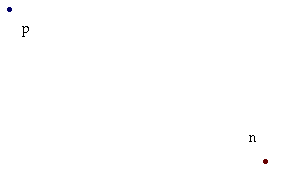The Strong Force
Strength
As its name implies, the strong force is the strongest of the four. This can be demonstrated by the fact that the nucleus of an atom is held together by the strong force. Remember, the nucleus consists of neutrons, which are electrically neutral, and protons, which are positively charged. All these positively charged particles will tend to electrically repel each other. Hence, if there's not another, stronger force holding them together, the nucleus of an atom would quickly blow apart.
Color and Color Confinement
The electromagnetic force is mediated by photons, which interact with particles that have electric charge. In the strong force, the mediating particles are gluons, and the property that they are alert to is not electric charge, but "color." Hence, at the fundamental level, only particles with color are affected by the strong force. Basically, this means quarks. In other words, quarks interact with each other by exchanging virtual gluons.
There are important differences between gluons and photons, and this has a profound effect on the behavior of the two forces they define. For one thing, while all photons are essentially identical, there are eight different gluons. Photons, although they define the electromagnetic force, have no actual electric charge themselves. Gluons suffer from no such irony: the eight different gluons are distinguished by their different colors. (These colors are kind of weird "color/anti-color" combinations, such as "blue/anti-red" and so forth.)
The fact that gluons have color is very important. One of the implications is that, while electromagnetism and gravity get weaker as objects get farther apart, the force between two quarks actually gets stronger as they get further apart. (You'll just have to trust me on this one.) This means that a quark bound up in a proton, for example, can't possibly escape from it. The upshot is that there are no lone quarks floating around. All quarks and gluons are tied up with other quarks or gluons to form particles which are colorless. Physicists never observe quarks directly, only particles such as protons, neutrons, pions (PIE-ons), kaons (KAY-ons) that contain quarks and gluons, but have no net color themselves. This property of the strong force is called "color confinement."
The Residual Strong Force
Atoms which have no net electric charge can still interact electrically, due to the fact that they are made up of particles that do have electric charge. We referred to this as the "residual" electromagnetic force. Well, there's a residual strong force as well. Protons and neutrons, which are colorless, can still exert a strong force on other protons and neutrons due to the fact that they're made up of particles that have color. In fact, in the case of the strong force, there are separate particles that mediate the residual force: pions.
Pions are particles that consist primarily of a quark and an anti-quark. There are three different pions, depending on what kind of quark and anti-quark are used. An up quark (charge = +2/3 times the charge of a proton) and a down anti-quark (charge = +1/3) make a pion that is positively charged. A down quark (charge = 1/3) and an up anti-quark (charge = 2/3) make a pion that is negatively charged. An up quark with an up anti-quark, or a down quark and anti-quark, make a pion that is electrically neutral. Protons (up up down quarks) and neutrons (up down down) interact with each other by the exchange of virtual pions.
 Gluons are still involved, but only in the process within a proton or neutron that creates a pion before sending it out, or in the process within a proton or neutron in which a pion is absorbed.
Gluons are still involved, but only in the process within a proton or neutron that creates a pion before sending it out, or in the process within a proton or neutron in which a pion is absorbed.
The Range of the Residual Force
Remember (from the last page) that the range of a force depends on the mass of the particle that mediates that force. In the case of electromagnetism, this was infinite because the photon is massless. The heavier the mediating particle, the shorter the range of the force. The pions have about 1/7 as much mass as a proton or neutron. This translates to a range of around 1015 meters. That is, about the size of a typical atomic nucleus. This is not a coincidence, really. The largest nuclei tend to be unstable, because their size is larger than this range. When the protons on one side of a nucleus start to lose touch with the protons on the other side, the nucleus has a harder time holding itself together. Anyway, the short range of the strong force is the reason that interactions between atoms are electromagnetic.
Actually, this was originally worked out backwards. In one of the more impressive feats of twentieth century physics, a Japanese physicist named Hideki Yukawa started with the range of the strong force, and used it to deduce what the mass of a virtual particle should be that mediates that force. When the pion was discovered some years later, with approximately the mass that Yukawa predicted, he got that big phone call from Stockholm.
The Weak Force
Previous page
Dave's Microcosmos

